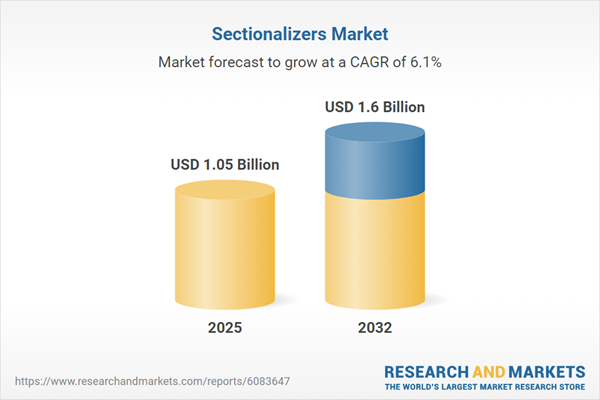Speak directly to the analyst to clarify any post sales queries you may have.
The electrical distribution transformer market is evolving rapidly, driven by regulatory demands, technological innovation, and a changing global supply chain landscape. Decision-makers in utilities, industry, and infrastructure must stay informed to manage risk and growth opportunities effectively in this dynamic sector.
Market Snapshot: Sectionalizers Market
The Sectionalizers Market grew from USD 999.19 million in 2024 to USD 1.05 billion in 2025. Ongoing expansion is anticipated at a CAGR of 6.09%, with the market projected to reach USD 1.60 billion by 2032. This growth reflects rising investments in grid reliability, renewable integration, and digital infrastructure upgrades across regional and global electricity networks.
Scope & Segmentation
This report provides comprehensive analysis and revenue forecasts across major segmentations and regions:
- Insulation Types: Air insulated, oil insulated, polymer insulated (epoxy resin, silicone polymer), and SF6 insulated.
- Construction Types: Pad mounted and pole mounted designs tailored to site logistics and maintenance requirements.
- End Users: Commercial complexes, data centers, retail and hospitality facilities, manufacturing, mining, oil and gas, petrochemical sectors, and utility organizations including cooperative utilities, investor-owned utilities, and municipal utilities.
- Applications: Overhead and underground distribution deployed to match urban, rural, and industrial settings.
- Distribution Channels: Direct sales for custom specifications, national or regional distributors, value-added resellers, and OEM partnerships at both Tier 1 and Tier 2 levels.
- Installation Types: New installations and retrofit projects supporting grid modernization and resilience upgrades.
- Technologies: Conventional transformer platforms, hybrid systems, and solid-state models enabling advanced grid management.
- Regions: Americas (North America, Latin America), Europe, Middle East, Africa, and Asia-Pacific, including national-level insights for the United States, Canada, Mexico, Brazil, Germany, India, China, Japan, and more.
- Key Companies: ABB Ltd, Schneider Electric SE, Siemens AG, Eaton Corporation plc, S&C Electric Company, General Electric Company, Hubbell Incorporated, Schweitzer Engineering Laboratories, Inc., Toshiba Corporation, Powell Industries, Inc.
Key Takeaways for Senior Decision-Makers
- Innovation in insulation media and construction—such as the adoption of polymer-insulated and modular designs—directly influences operational agility and environmental profiles in urban and industrial environments.
- Accelerated digital transformation is enabling predictive maintenance and remote asset management, empowering utilities and industrial stakeholders to improve performance and reduce unplanned downtimes.
- Shift towards advanced monitoring, condition-based diagnostics, and artificial intelligence is resulting in greater grid flexibility, improved safety, and actionable operational data.
- Ecosystem partnerships between OEMs, technology vendors, regulators, and academic institutions are expediting deployment of next-generation transformer solutions amid rising complexity and regulatory scrutiny.
- Market regionalization allows participants to align products and service models with local constraints—such as regulatory requirements, supply chain stability, and renewable project pipelines—supporting differentiated competitive strategies.
- Hybrid and solid-state transformer technologies are at the forefront, offering reductions in power loss and seamless integration with digital grid initiatives.
Assessing Tariff Impact on Procurement and Supply Chains
Recent United States tariff adjustments have introduced new cost structures for imported transformer components, prompting manufacturers and utilities to diversify suppliers and expand domestic production. This shift is driving longer-term procurement contracts, increased local fabrication, and supply chain recalibration. Utilities and end users are revising inventory management and capital spend schedules, with greater emphasis on design optimization and lifecycle cost assessments that factor in new policy uncertainties.
Research Methodology & Data Sources
The report applies a rigorous dual-stage methodology: robust secondary research from industry literature, regulatory publications, and technical white papers, plus structured interviews with market executives, engineers, and procurement specialists. Insights are triangulated and validated using quantitative industry data, supported by advisory review cycles and confidentiality protocols for unbiased, actionable conclusions.
Why This Report Matters
- Enables leadership teams to anticipate regulatory, technical, and supply chain shifts that affect long-term investment and operational decisions.
- Offers a transparent, segmented view of the market landscape, helping organizations tailor strategies for different end-use environments and regional markets.
- Delivers clear, actionable recommendations on technological adoption, procurement transformation, and resource allocation for sustained competitiveness and growth.
Conclusion
Organizations equipped with deep insight into insulation innovations, technology trends, and evolving supply chain challenges will be well positioned for future market leadership. Strategic planning backed by this report can support informed growth, optimized operations, and resilience in a rapidly shifting landscape.
Table of Contents
3. Executive Summary
4. Market Overview
7. Cumulative Impact of Artificial Intelligence 2025
Companies Mentioned
The companies profiled in this Sectionalizers market report include:- ABB Ltd
- Schneider Electric SE
- Siemens AG
- Eaton Corporation plc
- S&C Electric Company
- General Electric Company
- Hubbell Incorporated
- Schweitzer Engineering Laboratories, Inc.
- Toshiba Corporation
- Powell Industries, Inc.
Table Information
| Report Attribute | Details |
|---|---|
| No. of Pages | 198 |
| Published | November 2025 |
| Forecast Period | 2025 - 2032 |
| Estimated Market Value ( USD | $ 1.05 Billion |
| Forecasted Market Value ( USD | $ 1.6 Billion |
| Compound Annual Growth Rate | 6.0% |
| Regions Covered | Global |
| No. of Companies Mentioned | 11 |









